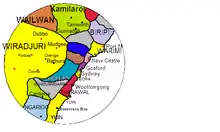Worimi language
Worimi (also spelt Warrimay), or Gadjang (also spelt Kattang, Kutthung, Gadhang, Gadang, Gathang) is an Australian Aboriginal language. It is the traditional language of the Worimi people, whose descendants now speak English. Work has started on revitalising the language with a dictionary and TAFE course in Gathang.[3]
| Worimi | |
|---|---|
| Gadhang | |
| Lower North Coast language | |
| Region | New South Wales |
| Ethnicity | Worimi, Birpai, Gringai |
| Extinct | (date missing) |
| Dialects |
|
| Language codes | |
| ISO 639-3 | kda – inclusive codeIndividual code: xbj – Birrpayi |
| Glottolog | wori1245 Worimi |
| AIATSIS[2] | E67 |
Classification

Worimi is most closely related to Awabakal, in the Yuin–Kuric group of Pama–Nyungan.
Bowern (2011) considers Gadjang, Worimi, and Birrpayi to be separate languages.
Phonology
Vowels
| Front | Back | |
|---|---|---|
| High | ɪ iː i ii | ʊ uː u uu |
| Low | ə aː a aa | |
There is also the diphthong "ay", pronounced [aj].
Consonants
| Bilabial | Velar | Dental | Palatal | Alveolar | |
|---|---|---|---|---|---|
| Voiceless Stop | p p | k k | t̪ th | c tj | t t |
| Voiced Stop | b b | g g | d̪ dh | ɟ dj | d d |
| Nasal | m m | ŋ ng | n̪ nh | ɲ ny/yn | n n |
| Lateral | l l | ||||
| Approximant | w w | j y | ɹ~ɾ r | ||
| Flap/Trill | ɾ~r rr | ||||
Within the orthography, both voiceless and voiced stops are written, words begin with voiced stops only and only voiced stops may occur in consonant clusters or suffixes. There is some inconsistency in the orthography to choice of stop intervocalically, the dictionary/grammar written by Amanda Lissarrague prescribes voiceless stops intervocalically, but this is violated many times such as in magu - axe. The phonemes /p/ and /b/ may contrast, such as gaparr - baby, boy, and gabarr - head. This is unclear.
There is some evidence of a merger of the dental and palatal stops/nasals, with free variation existing in many words, such as djinggarr~dhinggarr - silver, grey.
At the end of a word, a nasal may also be pronounced as its corresponding stop. (E.g. bakan~bakat - rock).
Intervocalically, "b" may be pronounced as [v].
References
- Dixon, R. M. W. (2002). Australian Languages: Their Nature and Development. Cambridge University Press. p. xxxiv.
- E67 Worimi at the Australian Indigenous Languages Database, Australian Institute of Aboriginal and Torres Strait Islander Studies
- Sati, Wiriya (2 April 2019). "Revitalising the Aboriginal language Gathang is about learning and speaking it together every day". ABC news. Retrieved 12 September 2019.
- This map is indicative only.
- Dixon, R. M. W. (2002). Australian Languages: Their Nature and Development. Cambridge University Press. ISBN 978-0-521-47378-1.
- Enright, W. J. (1900). "The Language, Weapons and Manufactures of the Aborigines of Port Stephens, N.S.W.". Journal and Proceedings of the Royal Society of New South Wales. 34: 103–188.
- Holmer, Nils M. (1966). An Attempt towards a Comparative Grammar of Two Australian Languages. Canberra: Australian Institute of Aboriginal Studies.
- Lissarrague, Amanda (2010). A grammar and dictionary of Gathang: The language of the Birrbay, Guringay and Warrimay. Nambucca Heads, N.S.W.: Muurrbay Aboriginal Language & Culture Co-operative.
External links
- Bibliography of Worimi people and language resources, at the Australian Institute of Aboriginal and Torres Strait Islander Studies
- Aboriginal Language the Kutthung